Chicken Caprese is your favorite salad turned into a juicy, fresh and satisfying 30-minute dinner (skillet or grilled!)
This Chicken Caprese recipe allows you to enjoy your favorite Caprese insalata for dinner! It’s a quick, season-and-cook, low carb meal made with simple ingredients that’s perfect for busy weeknights but also a fresh, vibrant win for company. This Chicken Caprese is made with juicy, pan seared Italian seasoned chicken topped with slices of melty mozzarella, thick juicy tomatoes and aromatic fresh basil all drizzled with swoon worthy, sweet and tangy balsamic reduction. It’s a hypnotic dance of juicy, fresh, cheesy, savory, earthy, sweet and tangy in each and every bite. Your family will love this chicken dinner with Parmesan breadsticks, Lemon Garlic Zucchini and Watermelon Salad for the ultimate feast.
I LOVE fresh and bright Caprese flavors and have celebrated them in my Caprese Avocado Chicken Wraps, Caprese Chicken Salad, Baked Chicken Caprese, Caprese Pasta with Balsamic Chicken and now this Caprese Chicken. I can’t wait for you to try them all!
Pin this recipe to save for later

CHICKEN CAprese RECIPE
My husband and I toured Italy a couple summers ago (see my IG highlights), and stuffed our faces with Caprese every change we got. It’s now a repeat at-home side/snack and I still can’t dine at an Italian restaurant without ordering it. Still, I don’t feel quite justified eating only Caprese for dinner – until now.
This Chicken Caprese recipe serves up slices of the heavenly appetizer – mozzarella, tomatoes and basil – layered over juicy golden chicken, for a satisfying meal the whole family will love.
Reasons to love this Chicken Caprese recipe:
- Delicious. Boldly seasoned chicken, juicy tomatoes, melty mozzarella, fresh basil and sweet and tangy balsamic reduction – does it get any better?
- Quick and easy. This quick and easy recipe requires just minutes of prep– the kind of chicken dinner that’s easy to throw together when you don’t feel like cooking (or doing dishes!) but tastes incredible. No marinating chicken, just season, slice and cook. You can even use store bought balsamic glaze if you prefer. In less than 30 minutes, you can be slicing into a little piece of Italy in your very own home.
- Simple ingredients. The fresh ingredients really shine in this recipe!
- Versatile. This Chicken Caprese can be made more or less cheesy (or omit the cheese all together), grilled or pan seared and served with low carb with zoodles or with your favorite pasta, potatoes, rice or risotto.
- Make ahead. You can pound the chicken, season the chicken, and slice all the toppings so all that’s left to do is cook!
What is Caprese?
Caprese refers to something from or in the style of Capri, an Italian island. Culinary speaking, “Caprese” refers to Caprese Salad, or insalata Caprese, made of thick slices of ripe tomatoes, slices of fresh mozzarella cheese and fresh basil. The salad is simply seasoned with salt, pepper, quality olive oil and balsamic vinegar or balsamic reduction. The salad is often presented on a platter with alternating tomato and mozzarella slices although it also can be stacked, tossed and even skewered.
What is Chicken Caprese?
This Chicken Caprese recipe turns the beloved classic salad into a complete dinner with the addition of Italian seasoned chicken all on your table in 30 minutes! It’s a quick and easy dinner that is sure to become a family favorite.
Caprese is already fabulous on its own, so it’s only right that the additional chicken be equally fabulous. This chicken isn’t bland, boring, flavorless or dry. Instead, it is stand-alone-scrumptious by pounded it thin for tenderness then seasoning with bold Italian seasonings to create a flavorful crust giving way to a buttery, juicy interior. Add the mozzarella the last few minutes to lightly melt, top with ripe tomatoes, basil and sweet and tangy balsamic reduction (AKA liquid gold) and dinner tastes like it’s from a 5-star Italian restaurant.
CHICKEN Caprese Recipe INGREDIENTS
This Chicken Caprese recipe is made with simple ingredients so it’s important to use the best! You will need (full measurements in the recipe card at the bottom of the post):
Chicken
Use 2 large chicken breasts sliced through the equator to create four cutlets or 4 small chicken breasts, roughly 5-7 ounces. The chicken will be pounded to a uniform thickness so it’s super tender without the need for a marinade. Thin pieces of chicken also cook more evenly, are more tender and soak up more flavor than whole chicken breasts. You may also use 4 skinless chicken thighs.
Fresh Tomatoes
Tomatoes are the star of Caprese so pick the best! If your tomatoes aren’t great, your Chicken Caprese won’t be either. I prefer firm, ripe, Roma tomatoes for their tangy, garden-fresh flavor but any ripe, seasonal, juicy, fresh tomatoes will work. To select ripe tomatoes, look for tomatoes that feel heavy for their size – unripe tomatoes will feel lighter. The tomatoes should be smooth, free of bruises, blemishes with a strong, sweet, earthy odor.
Mozzarella cheese
Fresh mozzarella cheese is a must for its sweet, delicate, milky, rich, creamy flavor and exquisite meltability. If you can find buffalo mozzarella, snatch it up because it’s even richer and creamier.
Look for logs of fresh mozzarella (it will literally say “fresh mozzarella”) like widely available BelGioisio brand with the specialty cheeses in the deli section. You will need about 8 ounces which you will slice into 8 slices so each piece of chicken can be blanketed in two pieces. If the fresh mozzarella already comes pre-sliced, that should be fine because most often the slices are pretty thick.
Please avoid cheap blocks of part skim mozzarella or pre-shredded mozzarella because it’s not nearly as creamy and flavorful and lacks the mouth-pleasing buttery texture as fresh mozzarella that’s quintessential to Caprese. These cheeses also don’t melt as well so if you must use them, plan on adding the cheese as soon as you flip the chicken over so it has time to melt.
Basil
Fresh basil is the only way to go when making Chicken Caprese! You can find fresh basil in the produce section of our grocery store in a small package or purchase a fresh basil plant which is around the same price (or cheaper) and keeps on giving!
Spices
The chicken is seasoned with homemade Italian seasoning consisting of dried basil, dried oregano, garlic powder, onion powder, salt and pepper. It’s a simple blend that packs a dynamite punch.
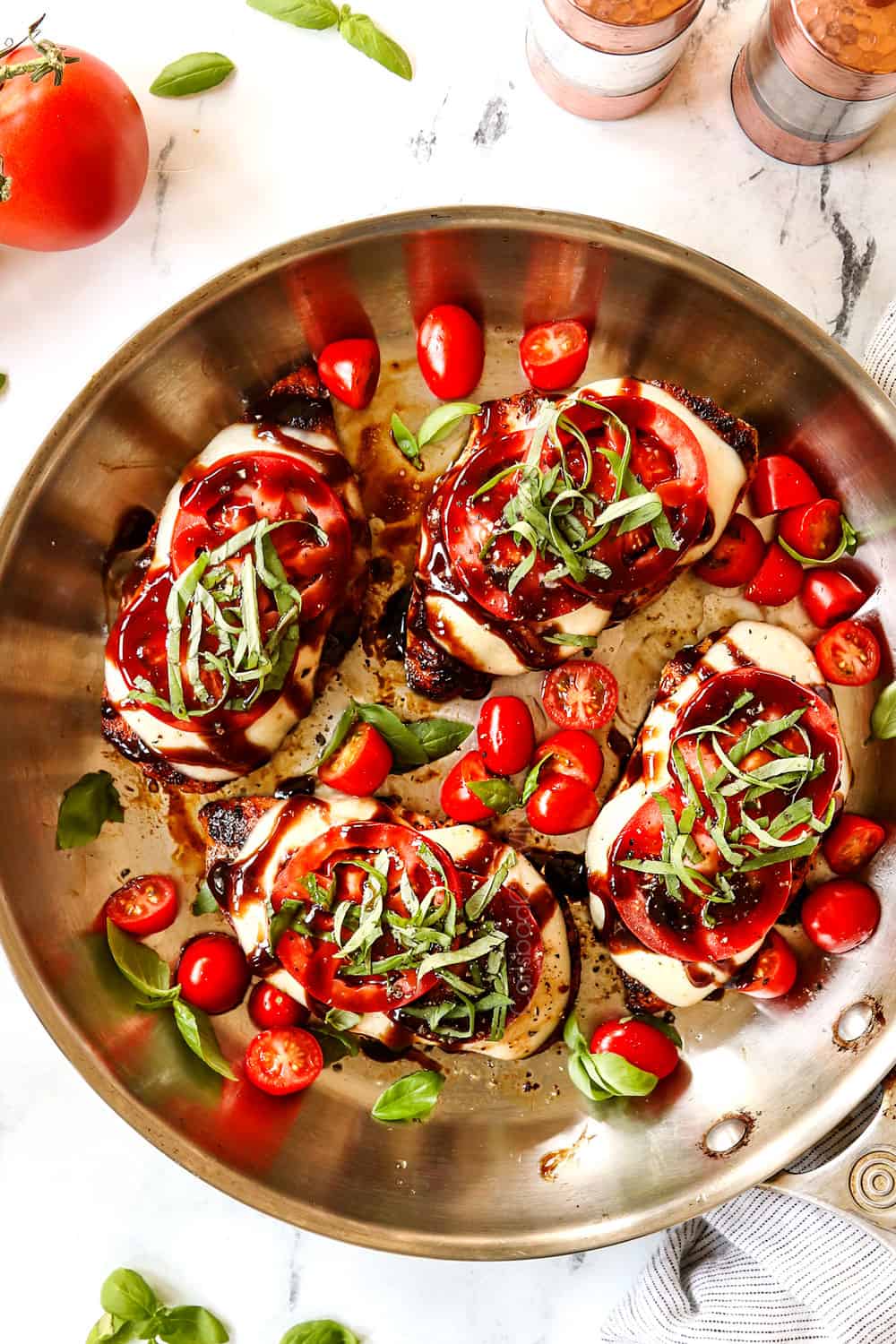
Traditional BALSAMIC, balsamic reduction, OR STORE BOUGHT Balsamic Glaze
Chicken Caprese is delightful on its own but simply not the same without a drizzle of traditional balsamic or balsamic glaze. The balsamic elevates it to dizzyingly delicious. Traditional balsamic can be incredibly expensive so balsamic glaze is a fabulous alternative to replicate the thick, syrupy sweet and tangy condiment. You can make your own or purchase it at the grocery store. Here is the breakdown:
traditional balsamic “Aged”
When I took a food tour in Bologna, Italy, we were served super pricey, thick, syrupy, traditional balsamic vinegar in a tiny jar drizzled over Parmigiano-Reggiano cheese. It was exquisite – because it is the best! Traditional balsamic vinegar is the purest, oldest, highest quality of vinegar and not the balsamic vinegar you’re used to tossing on your salad or in a marinade.
Traditional balsamic is aged for at least 12 years in which the flavors concentrate in batteries of casks of different woods without the addition of chemicals and aromatic substances. The cooked grape must ages into a rich, glossy, thick, dark brown syrup, much like our imitation balsamic reduction.
Traditional balsamic should not be used for cooking as heating it will kill the complex flavors and it would be wasted in a marinade. Instead, it should be used as a garnish on meats or a drizzling on cheeses, desserts and this Chicken Caprese!
Identification: The production of traditional balsamic vinegars is overseen from beginning to end by a special certification agency. It is always labelled Aceto Balsamico Tradizionale and carries a D.O.P. (“Denominazione di Origine Protetta”) stamp — a European Union certification that guarantees an ingredient’s quality, production, and place of origin. The color of the cap will let you know how long it has aged:
In Reggio Emilia:
- affinato (fine), with a red cap, roughly corresponds to a 12-year vintage
- vecchio (old), with a silver cap, roughly corresponds to a 15–20-year vintage
- extra vecchio (extra old), with a gold cap, roughly corresponds to a 20–25-year vintage.
In Modena, there is no vecchio, just affinato, with a white cap and extra vecchio, with a gold cap.
Balsamic Reduction
Traditional balsamic vinegar is not a pantry friendly, or pocket friendly item for many so balsamic reductions (“balsamic glaze”) is the next best choice. It is simply the reduction of less expensive balsamic vinegar and a splash of sweetener (brown sugar, honey or maple syrup) simmered in a sauce pan until it is the consistency of thick syrup, about 10 minutes.
As the balsamic vinegar reduces, it becomes less acidity, increasingly sweet and one of the most concentrated flavors of YUM you will ever taste. As the Pioneer Women puts it “sweet sticky gold.” Its sweet and tangy, caramelized, almost molasses undertones are made for Caprese – so please don’t skip it!
- Balsamic vinegar: the best quality balsamic vinegar for everyday use, (balsamic reduction, salads, marinades, etc.) is Balsamic Vinegar of Modena I.G.P. It is not fermented so it must contain wine vinegar in addition to the grape must to enhance its acidity but grape must be the first ingredient (otherwise it’s imitation). You can read all about balsamic vinegar in this post.
- To identify: I.G.P. should clearly be labeled and marked with the yellow-and-blue I.G.P. stamp (it shows two hillsides in a ring of stars). The vinegar can be designated “aged” if it has fermented for more than three years – a great sign. Some reputable brands include: Colavita, Due Vittorie Oro Gold, Oliviers & Co and Giuseppe Giusti Gran Deposito.
- Brown sugar: I like to use brown sugar as the sweetening agent but you may substitute with honey or maple syrup.
Store-Bought Balsamic Glaze
You can skip the simmering and instead purchase a bottle of balsamic glaze. This comes in super handy to drizzle on all your favorite salads, proteins, etc. You can find balsamic glaze next to the balsamic vinegars at the grocery store. Be aware, however, not balsamic glazes are created equal. Some are runnier and tangier as opposed to rich, sweet and tangy. Roland’s Balsamic Glaze is my personal favorite.

RECIPE VARIATIONS
This Chicken Caprese recipe stays pretty true to the classic Italian salad, but you are welcome to mix it up if you’d like. Here are a few recipe variations:
- Add pesto. Slather the chicken with a layer of pesto just before you add the mozzarella cheese.
- Marinate the chicken. Marinate the chicken in Italian dressing, pesto and a splash of lemon juice, the marinade used in my Tuscan chicken recipe or my fabulous balsamic chicken marinade.
- More or less cheese. You can make this recipe more or less cheesy by how thick you slice the mozzarella.
- Add Parmesan. Top the chicken off with thinly shaved Parmesan – yum! You may want to reduce the salt in the marinade if you’re planning to add Parmesan because it is quite salty.
- Omit cheese. You can omit the mozzarella (although I don’t recommend it) if you’re trying to save some calories.
- Add-ins. Sauté add-ins like sun-dried tomatoes, cherry tomatoes, and artichokes or any vegetables like zucchini, corn, bell peppers, mushrooms, etc. after you cook the chicken.
HOW TO MAKE CHICKEN Caprese
You are going to love how simple this Chicken Caprese recipe is to make! Let’s get cooking! (Full recipe measurements in the recipe card at the bottom of the post):
- Step 1: Make Balsamic Glaze (or use store-bought). Whisk vinegar and sugar together in a small nonreactive saucepan. Bring the mixture to a boil over high heat then reduce to a simmer just until the consistency of syrup, approximately 8-10 minutes, stirring occasionally. Don’t reduce too much because it will thicken slightly off heat. If it becomes too thick, stir in a little water over low heat.
- Step 2: Pound chicken to an even thickness. Whether you have small chicken breasts or chicken cutlets, you’ll want to pound them to an even thickness in order to tenderize the chicken and to help it cook evenly. Place the chicken in-between two pieces of plastic wrap (or I like to place my chicken in a large freezer size bag) and pound using the flat side of a meat mallet, rolling pin or side of a can. We are looking for about ½-inch thick.

- Step 3: Season the chicken. Mix all of the homemade Italian seasonings together in a small bowl. Pat the chicken dry then lightly drizzle both sides of the chicken with olive oil. Season both sides of the chicken evenly with the seasonings, rubbing them in a bit. Let the chicken rest while you prep the rest of the ingredients.
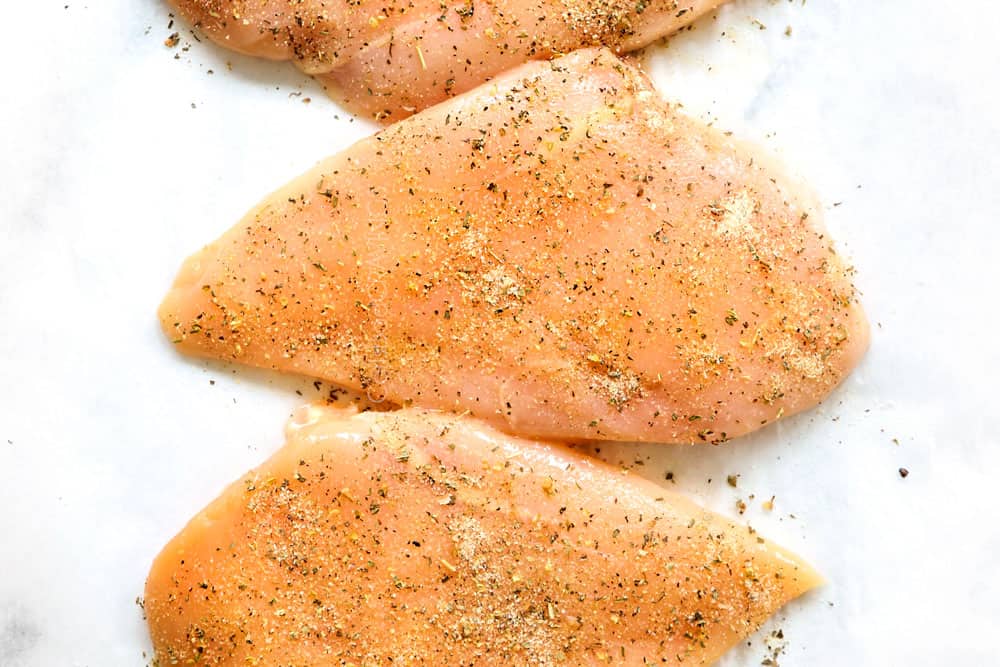
- Step 4: Cook the chicken in a skillet (grill instructions to follow). Heat some olive oil in a large skillet over medium-high heat. Once very hot, add chicken and cook for 3-4 minutes, or until deeply golden on one side. Flip chicken over, cover, and reduce heat to medium. Cook for about 1 minute or until chicken reaches 150 degrees.
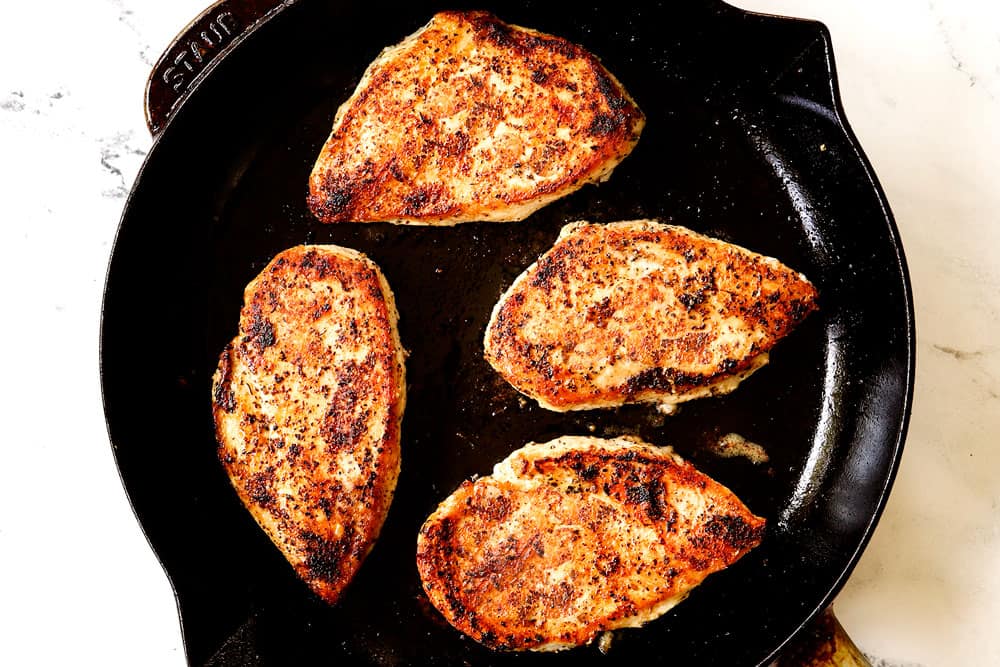
- Step 5: Add mozzarella. Top each piece of chicken with two slices of mozzarella and continue to cook until the chicken is cooked to 165 degrees F.
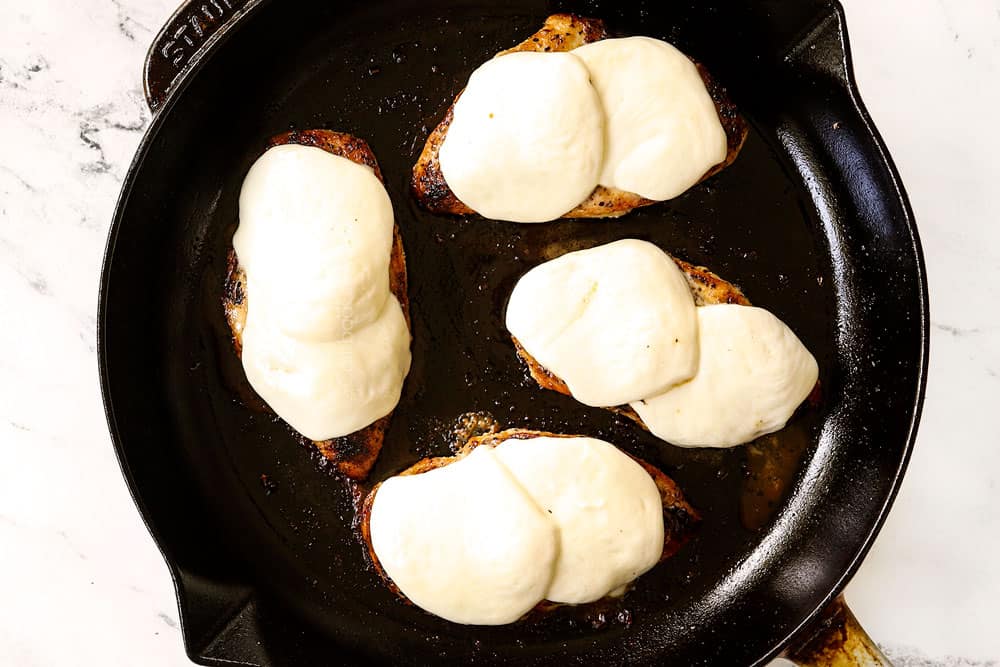
- Step 6: Add the rest. Top each piece of chicken with tomato slices, a drizzle of balsamic glaze and fresh basil. Serve immediately.
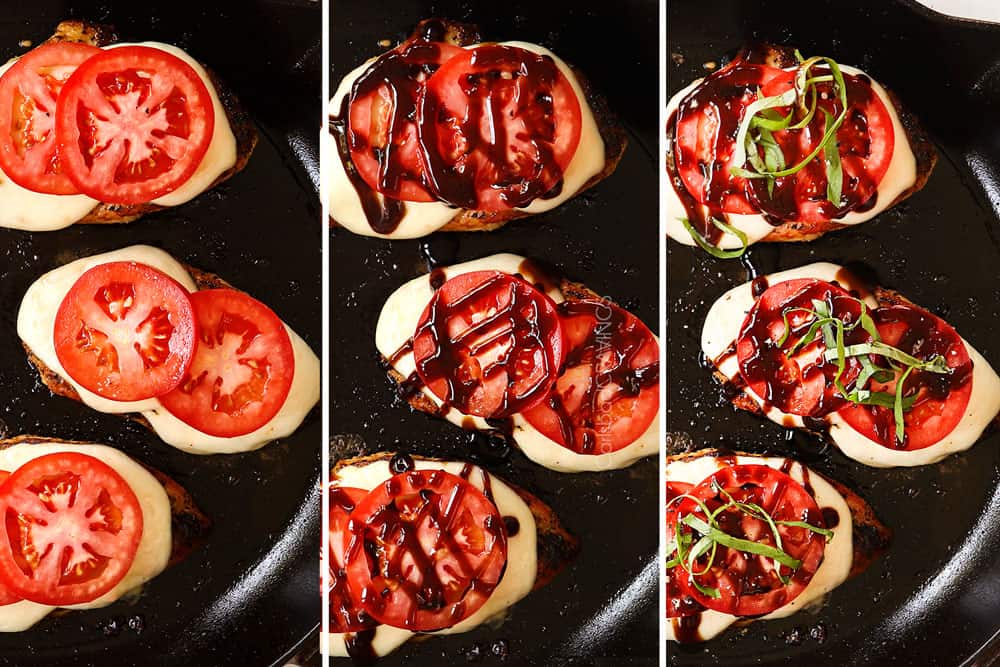

TO GRILL CHICKEN caprese
- Step 1: Make Balsamic Glaze (or use store-bought). Whisk vinegar and sugar together in a small nonreactive saucepan. Bring the mixture to a boil over high heat then reduce to a simmer just until the consistency of syrup, approximately 8-10 minutes, stirring occasionally. Don’t reduce too much because it will thicken slightly off heat. If it becomes too thick, stir in a little water over low heat.
- Step 2: Prepare grill. Preheat grill to 400 degrees, clean and grease grates.
- Step 3: Grill chicken: Add chicken to the hot grill and grill undisturbed for 4-6 minutes on the first side, until deep grill marks appear. Flip the chicken over using tongs and cook for 1-2 minutes, until the internal temperature of the chicken reaches 150 degrees F.
- Step 4: Add cheese. Top each piece of chicken with two slices of mozzarella and continue to cook until chicken is cooked through (an inserted thermometer reads 165 degrees F.)
- Step 6: Add the rest. Remove chicken to a serving plate. Top each piece of chicken with tomato slices, a drizzle of balsamic glaze and fresh basil. Serve immediately.
HOW DO I KNOW WHEN MY CHICKEN IS DONE?
Chicken breasts are done when they register 165 degrees F on an instant read thermometer. You can pick up an inexpensive instant read thermometer at the grocery store or Amazon, but a digital meat thermometer is the most accurate. I am obsessed with this digital probe thermometer – you will never overcook any protein again! It retrieves temperature precisely to within ±1.8°f (±1°c) and you leave the probes in the chicken while it cooks, whether on the grill, stove, or oven. The digital thermometer allows you to set the desired temperature and an alarm will set as soon as it reaches the set temperature.
TIPS FOR MAKING CHICKEN caprese
Chicken Caprese is very simple to make but there are few tips that transform your recipe from ordinary to extraordinary. Here’s what you need to know:
- Use the freshest ingredients possible. The most flavorful Caprese comes from fresh, ripe, juicy tomatoes that are sweet-smelling – so go seasonal!
- Don’t refrigerate the tomatoes. Instead, leave them on the counter until you’re ready to make the Chicken Caprese recipe. In simple terms, refrigerated tomatoes are far less flavorful and desirable. Science explains that the genes responsible for aroma compounds in tomatoes are turned off in a process called methylation when a tomato stays in a chilly environment.
- Use quality balsamic vinegar. Choose balsamic vinegar marked as made in Modena or the neighboring Reggio Emilia region in Italy. These two areas are famous for quality balsamic vinegar. The higher the grape must to vinegar ratio, the better the vinegar.
- Don’t skip pounding the chicken! Pound the thickest part of the chicken so it’s even with the thinnest part to ensure the chicken cooks evenly. Pounding the chicken is also crucial for tenderizing it.
- Bring chicken to room temperature before cooking. Let the chicken sit on the counter for 20-30 minutes before cooking. Room temperature chicken cooks more evenly and quickly which translates into juicier chicken because there is less time for moisture to be released while cooking.
- Dab the chicken of excess moisture. Before adding the olive oil, take a paper towel and pat the chicken dry so your chicken will sear instead of just steam – this is especially true if you are using frozen, thawed chicken which will release excess moisture.
- Use a hot pan. Add your chicken only once the pan is hot – you should hear the chicken sizzle the second it touches the pan. If you add chicken to a lukewarm pan, it will not sear, and as we all know from Gordon Ramsey, color = flavor. Searing the chicken results in the Maillard reaction, also known as the flavor reaction, in which amino acids and reducing sugars produce browning and complex flavor. Note, that hot doesn’t mean high heat, but it means it’s reached full temperature (medium-high in this case).
- Only flip chicken once. Resist the urge to move the chicken as it cooks or to flip it more than once. The chicken needs to stay in the same place for a continuous amount of time to sear, only then will it naturally release from the pan.
- Don’t overcook chicken. Chicken, especially chicken breasts, are juiciest when not overcooked. The best and most efficient way to check for doneness is to insert a meat thermometer into the chicken; chicken breasts are done when they register 165 degrees F.
- Let chicken rest. Let the grilled chicken rest for 5 minutes before slicing. This gives the juices that have pushed to the outside of the meat time to redistribute throughout the chicken. If you cut into the chicken immediately after cooking, valuable, moisture-giving juices will run out.
- Use a non-reactive pan to make the balsamic glaze. A nonreactive pan is one that will not react with acidic ingredients such as stainless steel, enamel or glazed finished pans, and many non-stick pans. Reactive pans should be avoided when cooking with acidic foods such as this balsamic glaze and tomato sauce because the material can react with the food and alter the flavor of the dish. These include aluminum, tin, cast iron and unlined copper.
- Stir the balsamic glaze often. It will seem like your reduction is taking a while to thicken then out of nowhere it will start to thicken so keep a careful eye on it and continue to stir so it doesn’t burn; once burned, it’s not salvageable.
- Balsamic glaze reduction time will vary. Balsamic vinegar quality varies so the time it takes to reduce your balsamic into a glaze will also vary (also due to other variables such as size of pan, pan material, actual heat, etc.). The more concentrated your vinegar is to begin with, the less time it will take, and vice versa.
- The glaze should be thick enough that it coats the back of a spoon. The glaze should be thick yet pourable, similar to warmed honey. The glaze will continue to thicken as it cools, so remove it from the heat a minute or two before it’s done or it will become too thick and harden.
- What if my glaze hardens? If your balsamic glaze is beginning to harden before you use it, then whisk in a little water and gently reheat over low to loosen.
- How to thicken glaze. On the opposite end of the spectrum, if you end up removing the glaze too early and it doesn’t thicken up after cooling, then return it to heat and simmer a little longer.
- Swap brown sugar. Instead of sugar, you may use honey or pure maple syrup (NOT imitation breakfast syrup).
- Omit sugar. You can also omit any sweetener entirely but your glaze won’t be as sweet and will take longer to reduce.
- It will smell. Don’t be alarmed at the strong smell emitted by the reducing vinegar -that’s normal!
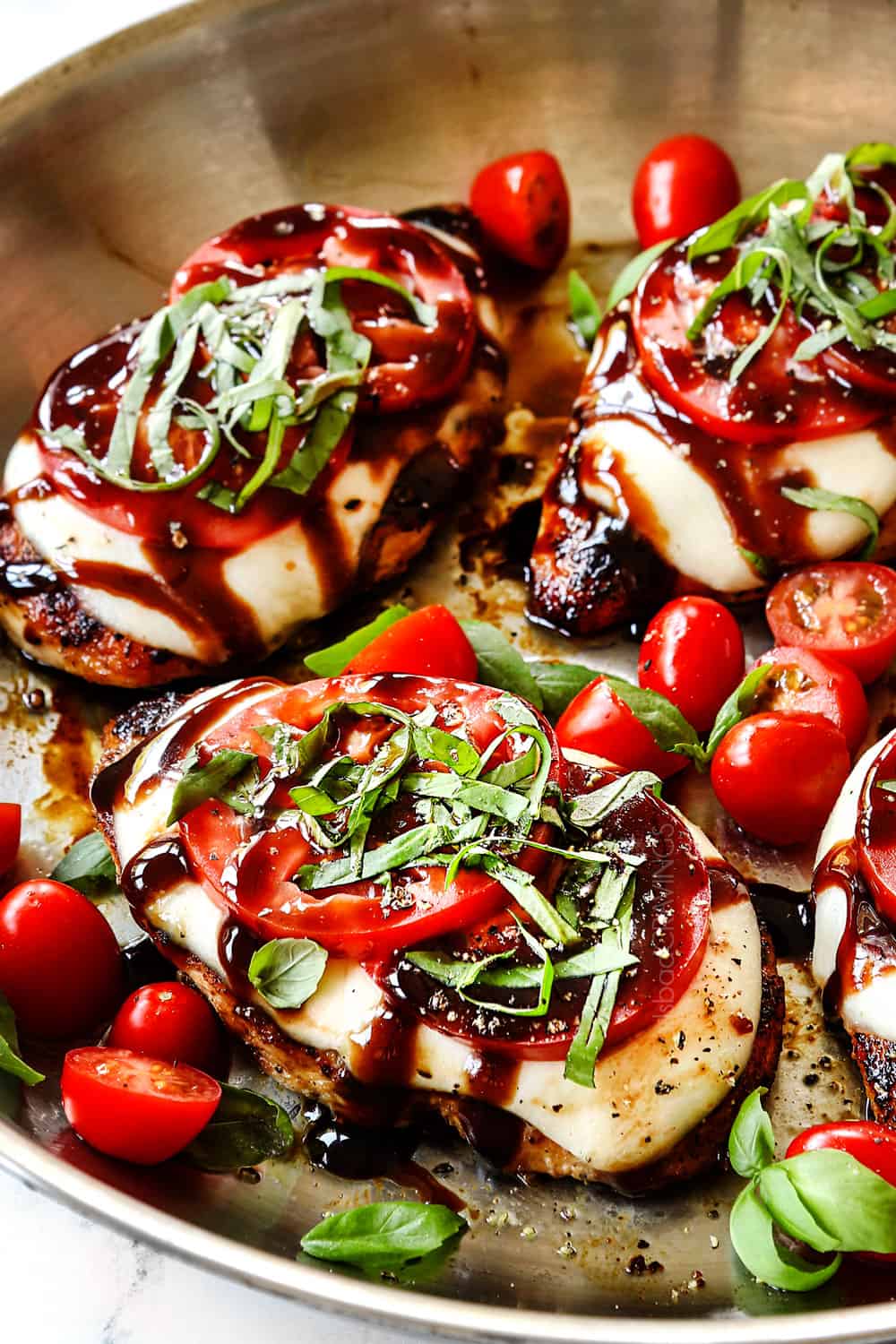
WHAT GOES with CHICKEN caprese?
There are many ways you can serve this Chicken Caprese. You can keep it low carb and serve with zoodles or go with pasta and sautéed veggies. Here are a few serving ideas:
- Pasta: serve alongside buttery noodles or other meatless pastas like Fettuccine Alfredo, Creamy Mushroom Orzo, Creamy Mushroom Spaghetti, Mac and Cheese, or Cacio e Pepe. You can also keep with the Italian theme and serve with Italian Pasta Salad.
- Rice and Risotto: I love the textural contrast of the juicy, cheesy chicken with rice. Serve this recipe with Rice Pilaf, Parmesan Risotto, Mushroom Risotto, or simple brown or white rice.
- Potatoes: serve over a bed of Mashed Potatoes, Smashed Sweet Potatoes or Pesto Mashed Potatoes or alongside Smashed Potatoes, Roasted Red Potatoes, Twice Baked Potatoes, Scalloped Potatoes or Hashbrown Casserole.
- Low carb: go low carb and serve Chicken Caprese with cauliflower rice, cauliflower mashed “potatoes,” zucchini noodles or spaghetti squash.
- Veggies: roasted, steamed, or sautéed veggies are fantastic with this Chicken Caprese recipe. Some of my favorites include Grilled Zucchini Baked Parmesan Asparagus, Roasted Broccoli, Sautéed Lemon Brussels Sprouts, Roasted Brussels Sprouts or Roasted Butternut Squash.
- Salad: if you skip the veggies, get your greens in from a big green salad, Caesar salad, Watermelon Salad, Wedge Salad, Strawberry Salad, Spinach Berry Salad or Apple Salad.
- Bread: we love Italian recipes (and let’s be honest, every recipe), with Garlic Bread, Soft and Fluffy Dinner Rolls or Garlic Parmesan Butter Breadsticks.
- Fruit: bright, fresh fruit is a must either in the form of fresh grapes, melon, etc. or in fruit salad form. We love Fruit Salad with Honey Lime Vinaigrette, Winter Fruit Salad with Honey Lime Poppy Seed Vinaigrette and Berry Salad in Honey Mascarpone.
Sides for Chicken Caprese
Ways to Use Leftovers
- Chicken Caprese Sandwiches: slather some pesto on toasted sourdough or toasted bread and top with Chicken Caprese.
- Pasta: chop up the Chicken Caprese and the toppings and add to pesto pasta or any of your favorite pastas.
- Salad: chop up the Chicken Caprese and add to a bed of greens along with additional tomatoes and veggies of choice. Dress with a balsamic vinaigrette.
- Wraps: slather tortillas or flatbread with pesto, top with greens, layer with Chicken Caprese and veggies of choice.
Can you make this recipe ahead of time?
You can prep portions of this recipe in advance so the final dish comes together quickly:
- Prep the seasoning: mix the seasonings together and store in an airtight container/plastic bag at room temperature for up to 6 months.
- Prep chicken: create chicken cutlets by slicing chicken breasts in half and pounding to an even thickness. Store in an airtight container in the refrigerator.
- Season chicken: go one step further and season the chicken. Transfer the chicken to a parchment lined plate in a single layer and tightly cover with plastic wrap. Store in the refrigerator.
- Prep fresh ingredients: chiffonade the basil and slice the mozzarella. Store in separate airtight containers/plastic bags in the refrigerator.
- Glaze: prepare the glaze according to directions, taking extra care to not to overcook. The glaze will continue to thicken as it cools. Let the glaze cool to room temperature then transfer to an airtight container such as a small glass jar or bowl. Store in the refrigerator for up to three weeks. Let stand at room temperature before serving.
HOW TO STORE AND REHEAT LEFTOVERS
- Storage: store the chicken in an airtight container in the refrigerator for 3-4 days.
- Microwave: chop up or slice the chicken so it reheats more evenly then transfer to a microwave safe dish. Heat for one minute then at 30 second intervals as needed.
- Oven: transfer chicken to an oven-proof dish. Cover with foil and reheat at 350 degrees F for 10 minutes or just until warmed through.
CAN I FREEZE THIS RECIPE?
You can freeze the chicken but the tomatoes don’t freeze and thaw well, they become, watery and mushy. To freeze the chicken without the tomatoes, let it cool completely then transfer it to an airtight container or plastic freezer bag and squeeze out any excess air. Freeze for 2 to 3 months.


Chicken Caprese
Save This Recipe To Your Recipe Box
You can now create an account on our site and save your favorite recipes all in one place!
Ingredients
CHICKEN
- 4 5-7 oz. chicken breasts or cutlets, pounded to an even thickness
- 1 tsp EACH onion powder, garlic powder, salt
- 1/2 tsp EACH dried oregano, dried basil, pepper
- 1 ½ tablespoons olive oil, plus more for drizzling
TOPPINGS
- 8 oz. fresh mozzarella, sliced into 8 even pieces
- 2 ripe tomatoes, sliced into thick slices
- fresh basil to taste, chiffonade
BALSAMIC GLAZE: (OR SUB STORE BOUGHT)
- 1 cup balsamic vinegar
- 2 tablespoons brown sugar
Serving Suggestions
Instructions
- Season chicken: Combine the chicken seasonings together in a small bowl. Lightly rub the chicken with olive oil then season each side. Set aside while you start the Balsamic Glaze.
- Balsamic Glaze: Whisk vinegar and sugar together in a small nonreactive saucepan (nonstick, stainless steel, enamel or glazed finished pans). Bring the mixture to a boil over high heat then reduce to a simmer just until the consistency of syrup, approximately 8-10 minutes, stirring occasionally. Don’t reduce too much because it will thicken slightly off heat. If it becomes too thick, stir in a little water over low heat.
- Cook chicken: You can start cooking the chicken while you're waiting for the glaze to thicken if you're good at multi-tasking (you don't want the glaze to burn!). Heat 1 ½ tablespoon olive oil in a large skillet over medium-high heat. Once very hot, add chicken and cook for 3-4 minutes, or until deeply golden on one side.
- Add mozzarella: Flip the chicken over, cover, and reduce heat to medium. Cook for approximately 1-2 additional minutes (depending on thickness), or until chicken is cooked to about 145 degrees F. Top each piece of chicken with two slices of mozzarella and continue to cook 2-3 minutes or until it registers 165 degrees on an instant read thermometer.
- Assemble: Remove chicken to a serving plate. Top each piece of chicken with tomato slices, a drizzle of balsamic glaze and fresh basil. Serve immediately.
Notes
TO GRILL CHICKEN caprese
- Preheat grill to 400 degrees, clean and grease grates.
- Add chicken to the hot grill and grill undisturbed for 4-6 minutes on the first side, until deep grill marks appear. Flip the chicken over using tongs and cook for 1-2 minutes, until the internal temperature of the chicken reaches 145 degrees F.
- Top each piece of chicken with two slices of mozzarella and continue to cook until chicken is cooked through (an inserted thermometer reads 165 degrees F.)
- Remove chicken to a serving plate. Top each piece of chicken with tomato slices, a drizzle of balsamic glaze and fresh basil. Serve immediately.
Expert Cooking Tips
- Chicken: Use 2 large chicken breasts sliced through the equator to create four cutlets or 4 small chicken breasts, roughly 5-7 ounces. You may also use 4 skinless chicken thighs. Don’t skip pounding the chicken!
- Balsamic Glaze: imitates pricier traditional balsamic vinegar that is aged at least 12 years. If you have quality aged balsamic, feel free to use that. You may also use store-bought balsamic glaze. My favorite is Roland’s Balsamic Glaze.
- Stir the balsamic glaze often. It will seem like your reduction is taking a while to thicken then out of nowhere it will start to thicken so keep a careful eye on it and continue to stir so it doesn’t burn; once burned, it’s not salvageable.
- Balsamic glaze reduction time will vary. Balsamic vinegar quality varies so the time it takes to reduce your balsamic into a glaze will also vary (also due to other variables such as size of pan, pan material, actual heat, etc.). The more concentrated your vinegar is to begin with, the less time it will take, and vice versa.
- How to thicken glaze. If you end up removing the glaze too early and it doesn’t thicken up after cooling, then return it to heat and simmer a little longer.
- It will smell. Don’t be alarmed at the strong smell emitted by the reducing vinegar -that’s normal!
How to store and reheat
- Storage: store the chicken in an airtight container in the refrigerator for 3-4 days.
- To freeze: You can freeze the chicken but the tomatoes don’t freeze and thaw well, they become, watery and mushy. To freeze the chicken without the tomatoes, let it cool completely then transfer it to an airtight container or plastic freezer bag and squeeze out any excess air. Freeze for 2 to 3 months.
- To reheat in the microwave: chop up or slice the chicken so it reheats more evenly then transfer to a microwave safe dish. Heat for one minute then at 30 second intervals as needed.
- To reheat in the oven: transfer chicken to an oven-proof dish. Cover with foil and reheat at 350 degrees F for 10 minutes or just until warmed through.

Did You Make This Recipe?
Tag @CarlsbadCravings and Use #CarlsbadCravngs
Leave a Review, I Always Love Hearing From You!


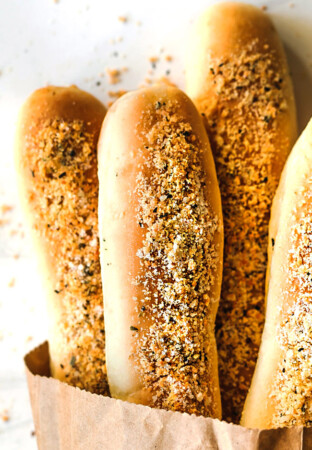
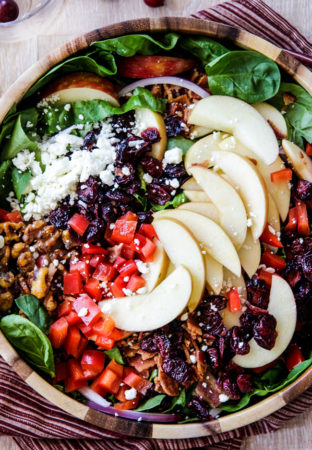

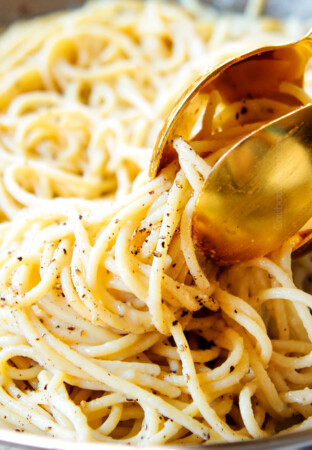
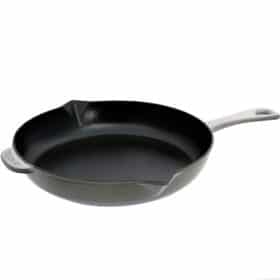
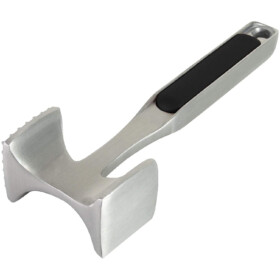
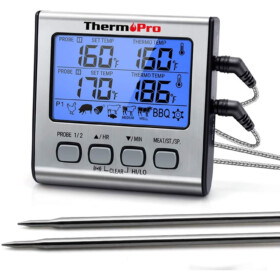
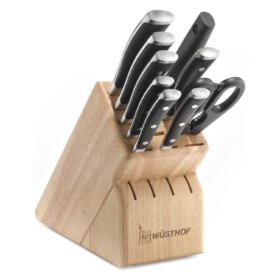
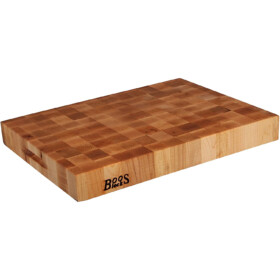
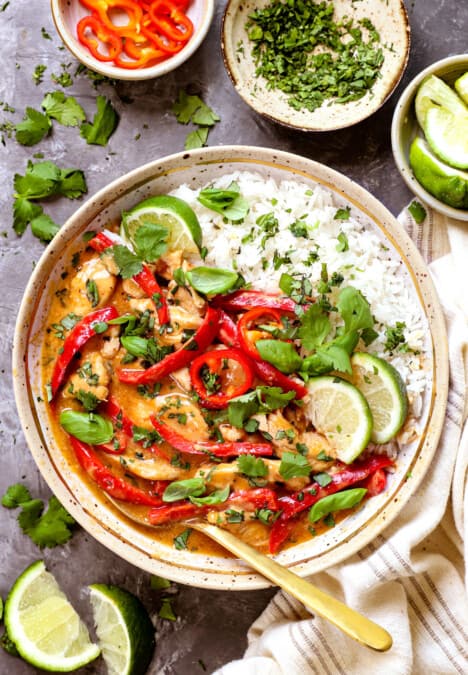

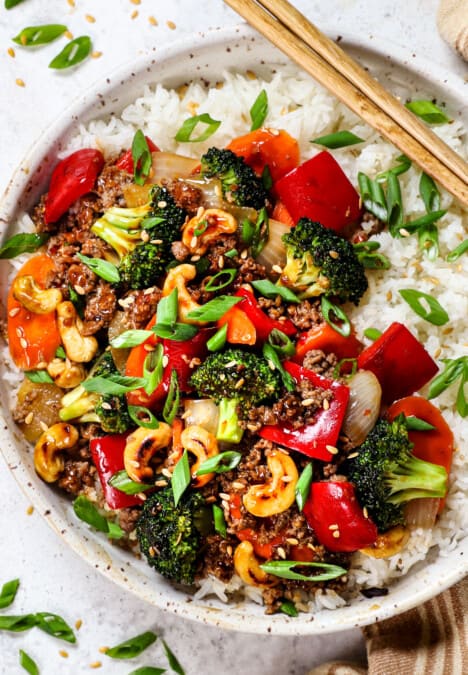


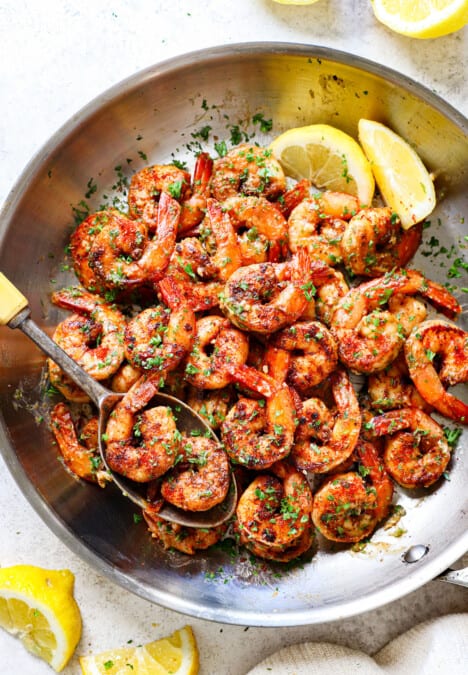























Gail L Wilson says
Another absolutely awesome recipe!!! This recipe is super simple and super delicious! I made this with the grilled zucchini and it was a complete hit at our dinner table. THANK YOU! You have given me the tools to be a “good cook” in my families eyes. Bless You!
Jen says
Thanks for making my day and being the first to review this new recipe Gail! I love hearing both recipes were huge hits and that your family is giving you the praise you deserve!
Sarah Teeters says
This was so delicious! I also love EVERYTHING Caprese, so add this to my list! I made it with mashed potatoes and though my glaze didn’t thicken up as much as I’d like it too, it was still there perfect sauce! Thank you for this deliciousness!
Jen says
You’re so welcome Sarah, I’m so pleased you loved it! For the glaze, try using the largest nonstick skillet you have and then just simmer until thickened- it may take longer depending on the balsamic.
Julia Haggerty says
I’m thoroughly loving reading your recipes in my email newsletter. Amazing information and a complete cooking lesson with each recipe!
Jen says
That is so kind of you, thanks Julia!
Diane Holland says
Jen,
While looking for a recipe I found your site. Your story is amazing and I am so touched by what you have been through and are able to take the time to give to these recipes well as share with us all .May God bless you and your family in all you do.
Thank you,
Diane Holland
Jen says
Thank you for your kind message Diane and for taking the time to read my story. May God bless you and yours as well! I hope you enjoy exploring my site and hopefully discover many new favorites xo
Liz says
Love this recipe. The chicken is seasoned well and the Caprese flavor with the chicken is perfect. Definitely a keeper!
Jen says
Yay! I am so happy you loved this recipe, Liz! Thank you so much! I love to hear that it’s a keeper!